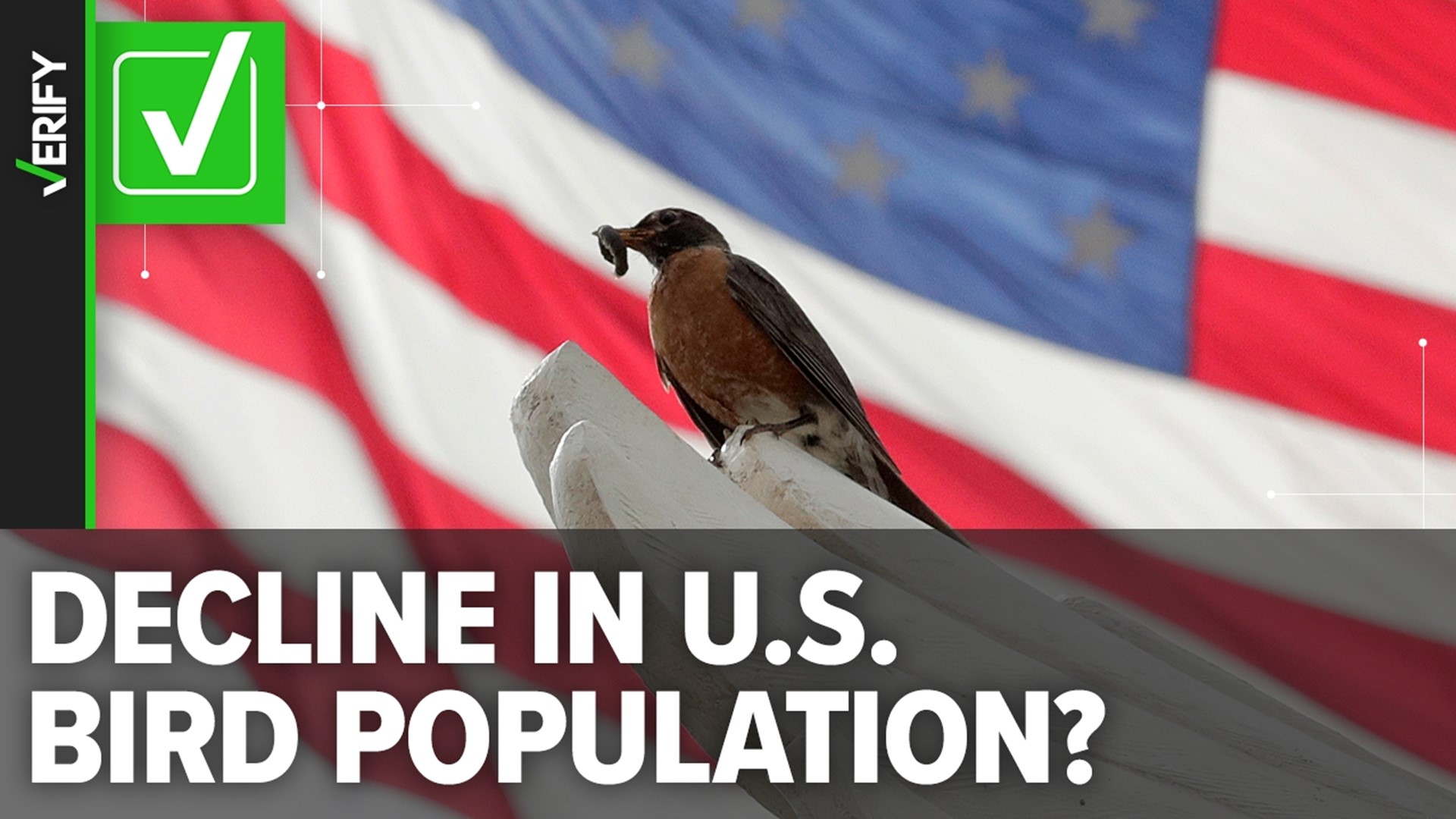People across the U.S. are used to seeing many birds in their daily lives; perhaps on bird feeders or trees in their yards, looking for crumbs on city streets, out on lakeshores and just about anywhere else people live.
But some people believe they’re seeing fewer birds than they used to and wonder if that’s because there actually are fewer birds. VERIFY reader Chrystal emailed us to ask if the bird population is in decline.
THE QUESTION
Is the U.S. bird population declining?
THE SOURCES
- U.S. North American Bird Conservation Initiative’s State of the Birds reports from 2009 and 2022
- 2019 study of North American bird populations by researchers from various bird and wildlife research and conservation organizations
- 2023 study of European bird populations by more than 50 researchers from various European bird and wildlife research organizations
- U.S. Fish and Wildlife Service
- Missouri Department of Conservation
- Center for Biological Diversity
THE ANSWER
Yes, the U.S. bird population is declining, and largely because of humans.
WHAT WE FOUND
The bird population in the U.S. has been in decline since the 1970s, according to reports by major conservation organizations from the last 14 years. Researchers attribute the decline to human-related factors such as habitat destruction, pesticides, climate change and even hunting by domesticated cats.
The most recent report from the U.S. North American Bird Conservation Initiative (NABCI) Committee, a coalition of government agencies, private organizations and bird initiatives, in 2022, concluded there are 3 billion fewer birds in the U.S. and Canada than there were 50 years ago.
Since 2009, NABCI has released reports on “The State of the Birds” for the United States. These reports are based on data collected from several bird population surveys.
The 2009 report found bird populations outside of wetland habitats have been declining since 1968. That trend has held true through multiple NABCI reports, including the 2022 State of the Birds, which concluded that the U.S. and Canada have lost one in every four breeding birds since 1970.
“Birds across the U.S. show downward trends in every habitat except in wetlands,” the 2022 report said. Waterfowl have been the exception because “four decades of wetlands conservation have generated spectacular comebacks of ducks and geese.”
The 2022 NACBI report credits successful policy and the North American Waterfowl Management Plan, an international agreement between the U.S., Canada and Mexico that provides a strategy for the long-term protection of wetlands and associated bird habitats in North America, for the success of waterfowl in the United States.
The U.S. Fish and Wildlife Service (FWS) says it leverages public-private partnerships to restore and preserve waterfowl populations and their wetland habitats. This includes partnering with hunters, who help fund FWS wetland protection efforts by purchasing federal duck stamps.
A 2019 study by researchers from various bird and wildlife research and conservation organizations found that more than half of the 529 North American bird species studied were declining. This trend extends to other parts of the globe; a 2023 study by more than 50 researchers from various European bird and wildlife research organizations also found that European bird populations generally declined between 1980 and 2016.
“It’s a perfectly destructive storm — climate change; habitat destruction; pesticide impacts; outdoor cats; persecution and downright negligent behavior — wreaking havoc on feathered beings around the globe,” J. Drew Lanham, Ph.D., a wildlife ecology professor at Clemson University, wrote in the 2022 State of the Birds report.
The FWS says habitat loss is believed to be “by far the greatest threat to birds, both directly and indirectly.”
In the Fish and Wildlife Service’s estimates of birds killed by human-caused sources, cats are believed to kill more birds than collisions with buildings and structures, cars, poison, electrocutions and oil pits combined. The Missouri Department of Conservation recommends people keep their cats indoors because “cats are the leading cause of death for wild birds.”
However, there are success stories of bird populations that have rebounded or otherwise grown in number over the last few decades, and these populations aren’t just limited to waterfowl.
The Center for Biological Diversity found that 85% of the 120 North American bird populations that have been listed as threatened or endangered since 1967 have increased or stabilized since their protection under the Endangered Species Act. Lanham named two of the most famous success stories in the 2022 State of the Birds report: the bald eagle and peregrine falcon.
Bald eagles and peregrine falcons were both on the verge of extinction in the mid-20th century because of widespread use of the insecticide DDT, which the Peregrine Fund and the FWS said weakened both birds’ eggshells and often made them unable to hatch. The FWS said habitat destruction and illegal shooting also played a part in the decline of bald eagles.
The two were among the first species listed under the Endangered Species Act; the FWS listed the bald eagle in 1967 and the peregrine falcon in 1970. The federal government banned DDT nationwide in 1972, which played a part in the recovery of the two species. Habitat protection and recovery efforts, as well as programs to breed the birds captively and then release them into the wild, also helped with recovery.
The peregrine falcon was delisted from the Endangered Species Act in 1999 and the bald eagle was delisted in 2007, in both cases because their populations recovered.
“This steep decline in abundance can be reversed with new scales of conservation actions that benefit not only birds but also wildlife and people,” the 2022 State of the Birds report said.












